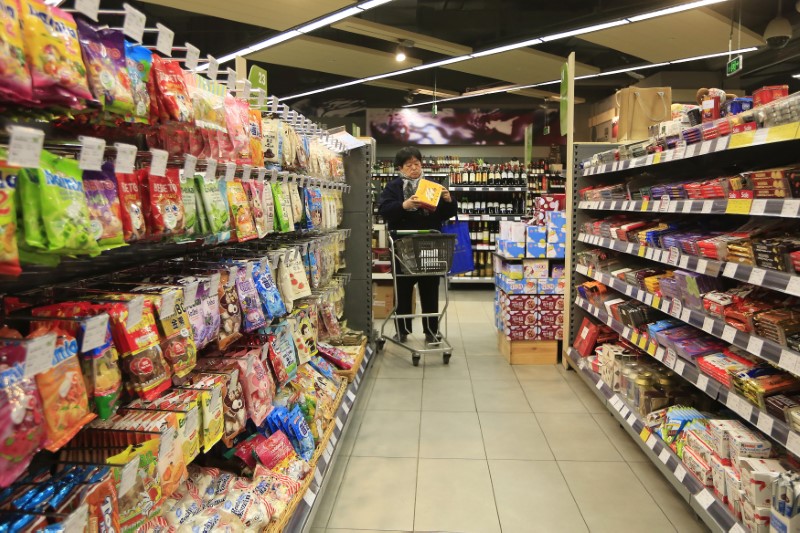
FILE PHOTO: A customer selects products at a supermarket in Shanghai, February 10, 2015. REUTERS/Aly Song
October 16, 2018
BEIJING (Reuters) – China’s factory-gate inflation cooled for a third straight month in September amid ebbing domestic demand, pointing to more pressure on the world’s second biggest economy as it remains locked in an intensifying trade war with the United States.
Consumer inflation, on the other hand, picked up slightly in September from the previous month, led mainly by higher food prices, official data showed on Tuesday.
Overall, pricing pressures were contained, giving authorities the flexibility to ease monetary policy to shore up slowing growth. Over the weekend, central bank governor Yi Gang said he sees plenty of room for adjustment in interest rates and banks’ reserve requirement ratio due to significant downside risks from the Sino-U.S. trade row.
Indeed, economic activity has been slackening in the past few months, prompting the People’s Bank of China (PBOC) to announce another cut to banks’ reserve requirement ratio (RRR) just over a week ago – the fourth reduction this year.
For this year, Yi said that CPI will likely come in about 2 percent and expects PPI between 3-4 percent.
The producer price index (PPI), a gauge of industrial profitability, rose 3.6 percent in September from a year earlier, compared with a 4.1 percent increase in August, according to data released by the National Statistics Bureau on Tuesday.
On a monthly basis, the PPI picked up to 0.6 percent from 0.4 percent in August.
Julian Evans-Pritchard, senior China economist at Capital Economics, noted that the small monthly rise in producer inflation mainly reflected an ‘unsustainable” increase in global oil price.
“The bigger picture is that broader factory gate price pressures still appear to be cooling alongside weaker economic activity,” he said in a client note following the data release.
Analysts polled by Reuters had expected September producer inflation would cool to 3.5 percent as both external and domestic demand weakened.
Price inflation in non-metallic mineral resources, metal smelting, chemicals and coal mining all slowed in September from previous month, while extraction in oil and natural gas extended its gains.
Raw materials prices rose 7.3 percent in September from a year earlier, down from a 7.8 percent increase in August, according to the statistics bureau.
Profit growth at China’s industrial firms slowed to a five-month low in August, fanning concerns about faltering domestic demand.
The trade row with Washington appears to be already impacting industries. Growth in China’s factory sector in September stalled after 15 months of expansion, with export orders falling the most in more than two years, a private business survey showed. An official survey also confirmed a further manufacturing weakening.
CPI PICKUP
The consumer price index (CPI) rose 2.5 percent from a year earlier, in line with expectations of 2.5 percent and accelerating from August’ s 2.3 percent gain. It still remained comfortably below China’s inflation goal of 3 percent for 2018, same as last year.
The food price index increased 3.6 percent in September, up sharply from the 1.7 percent annual gain in September, due to extreme weather conditions such as seasonal typhoons, heavy rains and hailstorms, according to the NBS.
Despite the pickup in the headline number, the core consumer price index, which strips out volatile food and energy prices, rose 1.7 percent year-on-year, cooling from 2.0 percent’s gain in August.
Gains in non-food prices also slowed to 2.2 percent from August’s 2.5 percent.
China’s economic growth cooled slightly to 6.7 percent in the second quarter, though worries about a sharper slowdown in coming quarters have increased in recent months amid the rocky trade relations with the United States.
The two countries have already slapped tit-for-tat tariffs on each other’s goods, and U.S. President Donald Trump has warned that he was ready to slap tariffs on virtually all Chinese imports into the United States.
If China goes ahead with a 15 percent tariff on $60 billion U.S. goods, it could lead to a one-time impact of a 0.2-0.3 percentage point gain on China’s consumer inflation, according to estimates from Morgan Stanley.
Yet, few expect the overall inflation picture to prevent further policy support for the economy.
“The recent rise in CPI is due to temporary disruptions to food supply and is unlikely to prevent the People’s Bank from loosening monetary policy further in the coming months in a bid to shore up economic growth,” said Evans-Pritchard.
(Reporting by Min Zhang, Stella Qiu and Ryan Woo; Editing by Shri Navaratnam)

